Trends in Adopting BIM, IoT and DT for Facility Management: A Scientometric Analysis and Keyword Co-Occurrence Network Review
Abstract
:1. Introduction
1.1. FM Definition and Functions
1.2. Current State of FM Practice
1.3. IoT and BIM for DT in FM
1.4. Structure of the Paper
2. Aim and Methodology
- Step 1: preliminary research;
- Step 2: database (DB) query;
- Step 3: data cleaning;
- Step 4: results’ visualization;
- Step 5: results’ discussion.
- (fm OR “facility management”) AND (iot OR “internet of things”) AND (“digital twin” OR dt) AND (bim OR “Building Information Modelling” OR “Building Information Modeling”) AND (“construction industry” OR “architectural engineering” OR aeco OR “construction management”) AND (LIMIT-TO (LANGUAGE, “English”))
3. Results’ Visualization and Discussion
3.1. Three-Field Plot Overview
3.2. Temporal Trends
3.2.1. Annual Scientific Production
3.2.2. Average Citation per Year Trend
3.2.3. Words’ Dynamics
3.3. Authors’ Analysis
3.3.1. Authors’ Productivity through Lotka’s Law
3.3.2. Most Relevant Authors
3.3.3. Authors’ Collaboration Network Analysis
- Edwards D.J., Professor at the Birmingham City University, UK;
- Chileshe N., Professor at the University of South Australia, Australia;
- Elghaish F., Lecturer at Queen’s University Belfast, Northern Ireland, UK;
- Hosseini M.R., Professor of the Daikin University, Australia;
- Olanrewaju O.I., PhD candidate at the Victoria University of Wellington, New Zealand;
- Ghosh A., Associate Researcher of the University of Deusto in Spain.
- Liu Y. of the University of Melbourne, Australia;
- Broyd T., Professor at the Bartlett Faculty of the Built Environment, London, UK;
- Chen K. Professor at the Huazhong University of Science and Technology, Wuhan, China;
- Cheng J.C.P., Professor of Civil and Environmental Engineering at the Hong Kong; University of Science and Technology, Hong Kong;
- Fang Y., Lecturer at Monash University, Clayton, Australia.
- Li X. Research Assistant Professor at the University of Hong Kong, Hong Kong;
- Lu W. Professor at the University of Hong Kong, Hong Kong;
- Xu J. Postdoctoral Fellow at the University of Hong Kong, Hong Kong;
- Chen J. Research Assistant Professor at the University of Hong Kong, Hong Kong.
3.3.4. Authors’ Impact
3.3.5. Most Cited Documents
- Modeling and pattern detection, which consists of creating readable model of the construction for the artificial intelligence, which can manage a large amount of complex information, in addition to pattern detection, which is useful for individuation through image and videos of “damage-like, crack-like, unsafety condition-like patterns for infrastructure condition assessment and construction safety assurance” [52];
- Prediction, which consists of the analysis of historical data for event prediction;
- Optimization, which consists of a “decision making process for seeking and delivering practical sustainable solutions to the construction project.”
3.4. Sources’ Analysis
3.4.1. Bradford’s Law
3.4.2. Sources’ Dynamics
3.4.3. Most Relevant Sources
3.4.4. Sources’ Impact
3.5. Social and Geographical Analysis
3.5.1. Countries Scientific Production
3.5.2. Most Relevant Affiliations
3.5.3. Country Collaboration Map
3.6. Bibliometric Networks
- Network visualization;
- Overlay visualization;
- Density visualization.
3.6.1. Co-Occurrence Keywords Network Visualization
3.6.2. Co-Occurrence Keywords Overlay Visualization
3.6.3. Co-Occurrence Keywords’ Density Visualization
3.7. Thematic Map
- The basic themes are in the lower-right quadrant. This quadrant includes not many developed themes but generic ones [74];
- The motor themes are in the upper-right quadrant. This quadrant includes themes with high centrality and density and are very important and developed for the related subject area [74];
- The Niche themes are in the upper-left quadrant. This quadrant refers to peripheral themes, which, even if they do not have very high importance, are very specialized and developed internal links [74];
- The Emerging/declining themes are in the lower-left quadrant. This quadrant includes themes with low centrality and density, but they could evolve in “more transcendental themes in the future” [74].
4. Conclusions
5. Future Research
Author Contributions
Funding
Institutional Review Board Statement
Informed Consent Statement
Conflicts of Interest
References
- Tay, L.; Ooi, J.T.L. Facilities management: A ‘Jack of all trades’? Facilities 2001, 19, 357–363. [Google Scholar] [CrossRef]
- History. Available online: https://www.ifma.org/about/about-ifma/history/ (accessed on 3 November 2022).
- Drion, B.; Melissen, F.; Wood, R. Facilities management: Lost, or regained? Facilities 2012, 30, 254–261. [Google Scholar] [CrossRef]
- What Is Facility Management? Available online: https://www.ifma.org/about/what-is-fm/ (accessed on 3 November 2022).
- ISO 41011:2017(en), Facility Management—Vocabulary. Available online: https://www.iso.org/obp/ui/#iso:std:iso:41011:ed-1:v1:en (accessed on 3 November 2022).
- Yalcinkaya, M.; Singh, V. Building information modeling (BIM) for facilities management—Literature review and future needs; Part of the IFIP International Conference on Product Lifecycle Management. In Product Lifecycle Management for a Global Market; Fukuda, S., Bernard, A., Gurumoorthy, B., Bouras, A., Eds.; Springer: Berlin/Heidelberg, Germany, 2014; pp. 1–10. [Google Scholar]
- Roper, K.; Payant, R. The Facility Management Handbook; AMACOM: Noord-Brabant, The Netherlands, 2014. [Google Scholar]
- Atkin, B.; Brooks, A. Total Facility Management; John Wiley & Sons: New York, NY, USA, 2021. [Google Scholar]
- IFMA. BIM for Facility Managers; John Wiley & Sons: New York, NY, USA, 2013. [Google Scholar]
- Wong, J.K.W.; Ge, J.; He, S.X. Digitisation in facilities management: A literature review and future research directions. Autom. Constr. 2018, 92, 312–326. [Google Scholar] [CrossRef]
- Guillen, A.J.; Crespo, A.; Gómez, J.; González-Prida, V.; Kobbacy, K.; Shariff, S. Building Information Modeling as Assest Management Tool. IFAC-PapersOnLine 2016, 49, 191–196. [Google Scholar] [CrossRef]
- Gallagher, M.P.; O’Conor, A.C.; Dettbarn, J.L., Jr.; Gilday, L.T. Cost Analysis of Inadequate Interoperability in the US Capital Facilities Industry; National Institute of Standards and Technology (NIST): Gaithersburg, MD, USA, 2004; pp. 223–253.
- Kelly, G.; Serginson, M.; Lockley, S.; Dawood, N.; Kassem, M. BIM FOR FACILITY MANAGEMENT: A REVIEW AND A CASE STUDY INVESTIGATING THE VALUE AND CHALLENGES. In Proceedings of the 13th International Conference on Construction Applications of Virtual Reality, London, UK, 30–31 October 2013; p. 11. Available online: https://www.researchgate.net/publication/312469604_BIM_for_facility_management_a_review_and_a_case_study_investigating_the_value_and_challenges (accessed on 3 November 2022).
- Deng, M.; Menassa, C.C.; Kamat, V.R. From BIM to digital twins: A systematic review of the evolution of intelligent building representations in the AEC-FM industry. ITcon 2021, 26, 58–83. [Google Scholar] [CrossRef]
- ISO 29481-1:2010(en), Building Information Modelling—Information Delivery Manual—Part 1: Methodology and Format. Available online: https://www.iso.org/obp/ui/#iso:std:iso:29481:-1:ed-1:v1:en (accessed on 9 November 2022).
- Dahanayake, K.C.; Sumanarathna, N. IoT-BIM-based digital transformation in facilities management: A conceptual model. J. Facil. Manag. 2021, 20, 437–451. [Google Scholar] [CrossRef]
- Madakam, S.; Lake, V.; Lake, V.; Lake, V. Internet of Things (IoT): A literature review. J. Comput. Commun. 2015, 3, 164. [Google Scholar] [CrossRef] [Green Version]
- Mannino, A.; Dejaco, M.C.; Cecconi, F.R. Building information modelling and internet of things integration for facility management—Literature review and future needs. Appl. Sci. 2021, 11, 3062. [Google Scholar] [CrossRef]
- Tang, S.; Shelden, D.R.; Eastman, C.M.; Pishdad-Bozorgi, P.; Gao, X. A review of building information modeling (BIM) and the internet of things (IoT) devices integration: Present status and future trends. Autom. Constr. 2019, 101, 127–139. [Google Scholar] [CrossRef]
- Seghezzi, E.; Locatelli, M.; Pellegrini, L.; Pattini, G.; Di Giuda, G.M.; Tagliabue, L.C.; Boella, G. Towards an occupancy-oriented digital twin for facility management: Test campaign and sensors assessment. Appl. Sci. 2021, 11, 3108. [Google Scholar] [CrossRef]
- Bujari, A.; Calvio, A.; Foschini, L.; Sabbioni, A.; Corradi, A. A Digital Twin Decision Support System for the Urban Facility Management Process. Sensors 2021, 21, 8460. [Google Scholar] [CrossRef] [PubMed]
- Digital Twins for IoT Applications—Oracle. 24 November 2018. Available online: https://pdf4pro.com/download/digital-twins-for-iot-applications-oracle-5b4880.html (accessed on 2 December 2022).
- Moral-Muñoz: Software Tools for Conducting Bibliometric Analysis in Science: An Up-to-Date Review—Google Scholar. Available online: https://scholar.google.com/scholar_lookup?oi=gsb80&journal_title=Profesional%20de%20la%20informaci%C3%B3n&journal_abbrev=Profesional%20de%20la%20informaci%C3%B3n&issn=1699-2407&author=Jos%C3%A9%20A.%20Moral-Mu%C3%B1oz&author=Enrique%20Herrera-Viedma&author=Antonio%20Santisteban-Espejo&author=Manuel%20J.%20Cobo&title=Software%20tools%20for%20conducting%20bibliometric%20analysis%20in%20science%3A%20An%20up-to-date%20review&language=en&year=2020%2F01%2F19&volume=29&issue=1&doi=10.3145%2Fepi.2020.ene.03&lookup=0&hl=it (accessed on 9 November 2022).
- Burnham, J.F. Scopus database: A review. Biomed. Digit. Libr. 2006, 3, 1. [Google Scholar] [CrossRef] [Green Version]
- Cantu-Ortiz, F.J. Research Analytics: Boosting University Productivity and Competitiveness through Scientometrics; CRC Press: Boca Raton, FL, USA, 2017. [Google Scholar]
- Underwood, S. Blockchain beyond bitcoin. Commun. ACM 2016, 59, 15–17. [Google Scholar] [CrossRef]
- Pereira, S.; Nanayakkara, S.; Rodrigo, M.N.N.; Senaratne, S.; Weinand, R. Blockchain technology: Is it hype or real in the construction industry? J. Ind. Inf. Integr. 2020, 17, 100125. [Google Scholar] [CrossRef]
- Zheng, Z.; Xie, S.; Dai, H.N.; Chen, X.; Wang, H. Blockchain challenges and opportunities: A survey. Int. J. Web Grid Serv. 2018, 14, 352. [Google Scholar] [CrossRef]
- Gunasekara, H.G.; Sridarran, P.; Rajaratnam, D. Effective use of blockchain technology for facilities management procurement process. J. Facil. Manag. 2021, 20, 452–468. [Google Scholar] [CrossRef]
- The Past and Future of Blockchain in FM. Available online: http://fmj.ifma.org/article/The+Past+and+Future+of+Blockchain+in+FM/3041474/483818/article.html (accessed on 10 November 2022).
- Abioye, S.O.; Oyedele, L.O.; Akanbi, L.; Ajayi, A.; Delgado, J.M.D.; Bilal, M.; Akinade, O.O.; Ahmed, A. Artificial Intelligence in the Construction Industry: A Review of Present Status, Opportunities and Future Challenges. J. Build. Eng. 2021, 44, 103299. [Google Scholar] [CrossRef]
- Villa, V.; Bruno, G.; Aliev, K.; Piantanida, P.; Corneli, A.; Antonelli, D. Machine Learning Framework for the Sustainable Maintenance of Building Facilities. Sustainability 2022, 14, 681. [Google Scholar] [CrossRef]
- Culot, G.; Nassimbeni, G.; Orez, G.; Sartor, M. Behind the definition of Industry 4.0: Analysis and open questions. Int. J. Prod. Econ. 2020, 226, 107617. [Google Scholar] [CrossRef]
- Erboz, G. How To Define Industry 4.0: Main Pillars Of Industry 4.0. In Managerial Trends in the Development of Enterprises in Globalization Era; Slovak University of Agriculture: Nitra, Slovakia, 2017; Available online: https://www.researchgate.net/publication/326557388_How_To_Define_Industry_40_Main_Pillars_Of_Industry_40 (accessed on 3 November 2022).
- Sawhney, A.; Riley, M.; Irizarry, J. (Eds.) Construction 4.0: An Innovation Platform for the Built Environment; Routledge: New York, NY, USA, 2020. [Google Scholar]
- Lau, W.K.; Ho, K.M.K.; Lam, T.Y.M.; Ma, T.; Chan, H.C.K.; Tsang, C.W.A. Age Composition and Survival of Public Housing Stock in Hong Kong; Thei: Hong Kong, China, 2017; p. 1052. [Google Scholar]
- Velez-Estevez, A.; García-Sánchez, P.; Moral-Munoz, J.A.; Cobo, M.J. Why do papers from international collaborations get more citations? A bibliometric analysis of Library and Information Science papers. Scientometrics 2022, 127, 1–39. [Google Scholar] [CrossRef]
- Ibanez, A.; Bielza, C.; Larranaga, P. Relationship among research collaboration, number of documents and number of citations: A case study in Spanish computer science production in 2000–2009. Scientometrics 2013, 95, 689–716. [Google Scholar] [CrossRef]
- Bibliometric Modeling Processes and the Empirical—ProQuest. Available online: https://www.proquest.com/docview/216894863?pq-origsite=gscholar&fromopenview=true (accessed on 25 October 2022).
- Newby, G.B.; Greenberg, J.; Jones, P. Open source software development and Lotka’s Law: Bibliometric patterns in programming. J. Am. Soc. Inf. Sci. Technol. 2003, 54, 169–178. [Google Scholar] [CrossRef]
- Engqvist, L.; Frommen, J.G. The h-index and self-citations. Trends Ecol. Evol. 2008, 23, 250–252. [Google Scholar] [CrossRef] [PubMed] [Green Version]
- Ball, P. Achievement index climbs the ranks. Nature 2007, 448, 737. [Google Scholar] [CrossRef]
- Egghe, L. An Improvement of the h-Index: The g-Index; ISSI: Leuven, Belgium, 2006; p. 4. [Google Scholar]
- Dinis-Oliveira, R.J. The H-index in Life and Health Sciences: Advantages, Drawbacks and Challenging Opportunities. Curr. Drug Res. Rev. 2019, 11, 82–84. [Google Scholar] [CrossRef]
- Costas, R.; Bordons, M. Is g-index better than h-index? An exploratory study at the individual level. Scientometrics 2008, 77, 267–288. [Google Scholar] [CrossRef] [Green Version]
- Kelly, C.D.; Jennions, M.D. The h index and career assessment by numbers. Trends Ecol. Evol. 2006, 21, 167–170. [Google Scholar] [CrossRef]
- Batista, P.D.; Campiteli, M.G.; Kinouchi, O. Is it possible to compare researchers with different scientific interests? Scientometrics 2006, 68, 179–189. [Google Scholar] [CrossRef]
- Egghe, L. Theory and practise of the g-index. Scientometrics 2006, 69, 131–152. [Google Scholar] [CrossRef]
- Sidiropoulos, A.; Katsaros, D.; Manolopoulos, Y. Generalized Hirsch h-index for disclosing latent facts in citation networks. Scientometrics 2007, 72, 253–280. [Google Scholar] [CrossRef] [Green Version]
- Aithal, S. Comparative Study of Various Research Indices used to measure quality of Research Publications. Int. J. Appl. Adv. Sci. Res. 2017, 2, 81–89. [Google Scholar] [CrossRef]
- Boje, C.; Guerriero, A.; Kubicki, S.; Rezgui, Y. Towards a semantic Construction Digital Twin: Directions for future research. Autom. Constr. 2020, 114, 103179. [Google Scholar] [CrossRef]
- Pan, Y.; Zhang, L. Roles of artificial intelligence in construction engineering and management: A critical review and future trends. Autom. Constr. 2021, 122, 103517. [Google Scholar] [CrossRef]
- Patra, S.K.; Bhattacharya, P.; Verma, N. Bibliometric Study of Literature on Bibliometrics. DESIDOC Bull. Inf. Technol. 2006, 26, 27–32. [Google Scholar] [CrossRef]
- Alabi, G. Bradford’s law and its application. Int. Libr. Rev. 1979, 11, 151–158. [Google Scholar] [CrossRef]
- Nash-Stewart, C.E.; Kruesi, L.M.; Del Mar, C.B. Does Bradford’s Law of Scattering predict the size of the literature in Cochrane Reviews? J. Med. Libr. Assoc. 2012, 100, 135–138. Available online: https://www.ncbi.nlm.nih.gov/pmc/articles/PMC3324807/ (accessed on 26 October 2022). [CrossRef] [Green Version]
- Van Eck, N.J.; Waltman, L. VOSviewer Manual; Univeristeit Leiden: Leiden, The Netherlands, 2013; Volume 1, pp. 1–53. [Google Scholar]
- Van Eck, N.J.; Waltman, L. Software survey: VOSviewer, a computer program for bibliometric mapping. Scientometrics 2009, 84, 523–538. [Google Scholar] [CrossRef] [Green Version]
- Van Eck, N.J.; Waltman, L. VOS: A new method for visualizing similarities between objects. In Advances in Data Analysis; Decker, R., Lenz, H.-J., Eds.; Springer: Berlin/Heidelberg, Germany, 2007; pp. 299–306. [Google Scholar]
- Rasheed, A.; San, O.; Kvamsdal, T. Digital Twin: Values, Challenges and Enablers From a Modeling Perspective. IEEE Access 2020, 8, 21980–22012. [Google Scholar] [CrossRef]
- Tao, F.; Qi, Q.; Wang, L.; Nee, A.Y.C. Digital Twins and Cyber—Physical Systems toward Smart Manufacturing and Industry 4.0: Correlation and Comparison. Engineering 2019, 5, 653–661. [Google Scholar] [CrossRef]
- Gamayunova, O.; Vatin, N. BIM-Technology in Architectural Design. Adv. Mater. Res. 2014, 1065–1069, 2611–2614. [Google Scholar] [CrossRef]
- BIM Definitions. [Online]. Available online: https://www.ace-cae.eu/fileadmin/New_Upload/3._Area_2_Practice/BIM/Other_Docs/1_S.Mordue_Definition_of_BIM_01.pdf (accessed on 24 October 2022).
- Azhar, S.; Brown, J.; Farooqui, R. BIM-based Sustainability Analysis: An Evaluation of Building Performance Analysis Software. In Proceedings of the 45th ASC Annual Conference, Gainesville, FL, USA, 1–4 April 2009; p. 10. [Google Scholar]
- Forcael, E.; Ferrari, I.; Opazo-Vega, A.; Pulido-Arcas, J.A. Construction 4.0: A literature review. Sustainability 2020, 12, 9755. [Google Scholar] [CrossRef]
- Li, J.; Kassem, M. Applications of distributed ledger technology (DLT) and Blockchain-enabled smart contracts in construction. Autom. Constr. 2021, 132, 103955. [Google Scholar] [CrossRef]
- ARUP. Blockchain Technology. Available online: https://www.arup.com/perspectives/publications/research/section/blockchain-technology (accessed on 11 November 2022).
- Ganter, M.; Lützkendorf, T. Information management throughout the life cycle of buildings—Basics and new approaches such as blockchain. IOP Conf. Ser. Earth Environ. Sci. 2019, 323, 012110. [Google Scholar] [CrossRef] [Green Version]
- Liu, Z.; Chi, Z.; Osmani, M.; Demian, P. Blockchain and building information management (BIM) for sustainable building development within the context of smart cities. Sustainability 2021, 13, 2090. [Google Scholar] [CrossRef]
- Li, J.; Greenwood, D.; Kassem, M. Blockchain in the built environment and construction industry: A systematic review, conceptual models and practical use cases. Autom. Constr. 2019, 102, 288–307. [Google Scholar] [CrossRef]
- Cheng, J.C.P.; Chen, W.; Chen, K.; Wang, Q. Data-driven predictive maintenance planning framework for MEP components based on BIM and IoT using machine learning algorithms. Autom. Constr. 2020, 112, 103087. [Google Scholar] [CrossRef]
- Lee, J.Y.; Irisboev, I.O.; Ryu, Y.-S. Literature Review on Digitalization in Facilities Management and Facilities Management Performance Measurement: Contribution of Industry 4.0 in the Global Era. Sustainability 2021, 13, 13432. [Google Scholar] [CrossRef]
- Aria, M.; Cuccurullo, C.; D’Aniello, L.; Misuraca, M.; Spano, M. Thematic Analysis as a New Culturomic Tool: The Social Media Coverage on COVID-19 Pandemic in Italy. Sustainability 2022, 14, 3643. [Google Scholar] [CrossRef]
- Language and Communication in International Students’ Adaptation: A Bibliometric and Content Analysis Review. Available online: https://www.researchgate.net/publication/361965772_Language_and_communication_in_international_students%27_adaptation_a_bibliometric_and_content_analysis_review/figures?lo=1&utm_source=google&utm_medium=organic (accessed on 26 October 2022).
- The Organizational Commitment in the Company and Its Relationship with the Psychological Contract. Available online: https://www.researchgate.net/publication/348479945_The_Organizational_Commitment_in_the_Company_and_Its_Relationship_With_the_Psychological_Contract/figures?lo=1&utm_source=google&utm_medium=organic (accessed on 26 October 2022).
- Elghaish, F.; Matarneh, S.; Talebi, S.; Kagioglou, M.; Hosseini, M.R.; Abrishami, S. Toward digitalization in the construction industry with immersive and drones technologies: A critical literature review. Smart Sustain. Built Environ. 2020, 10, 345–363. [Google Scholar] [CrossRef]
- Golizadeh, H.; Hon, C.K.H.; Drogemuller, R.; Hosseini, M.R. Digital engineering potential in addressing causes of construction accidents. Autom. Constr. 2018, 95, 284–295. [Google Scholar] [CrossRef]
- Newman, C.; Edwards, D.; Martek, I.; Lai, J.; Thwala, W.D.; Rillie, I. Industry 4.0 deployment in the construction industry: A bibliometric literature review and UK-based case study. Smart Sustain. Built Environ. 2021, 10, 557–580. [Google Scholar] [CrossRef]
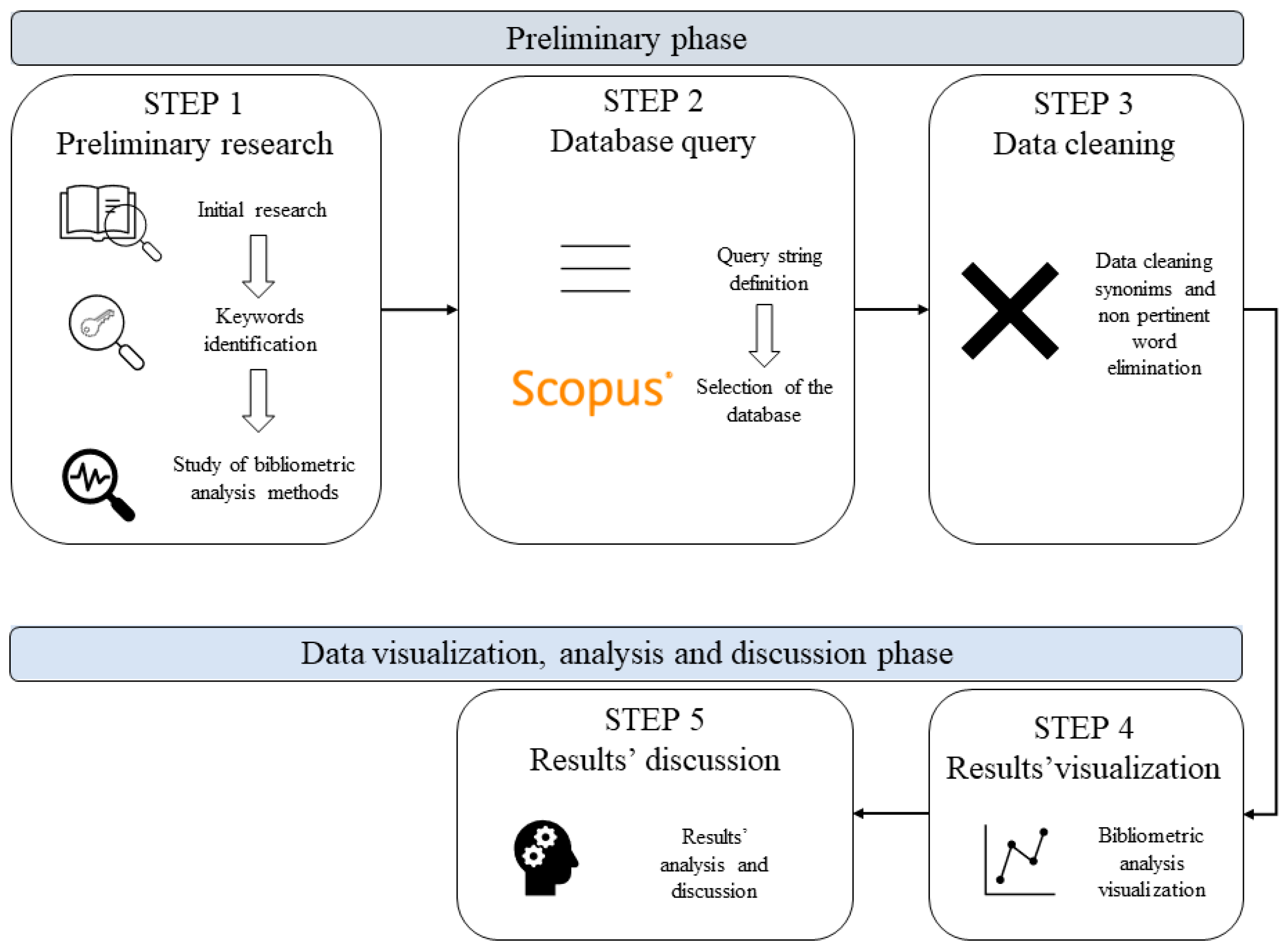
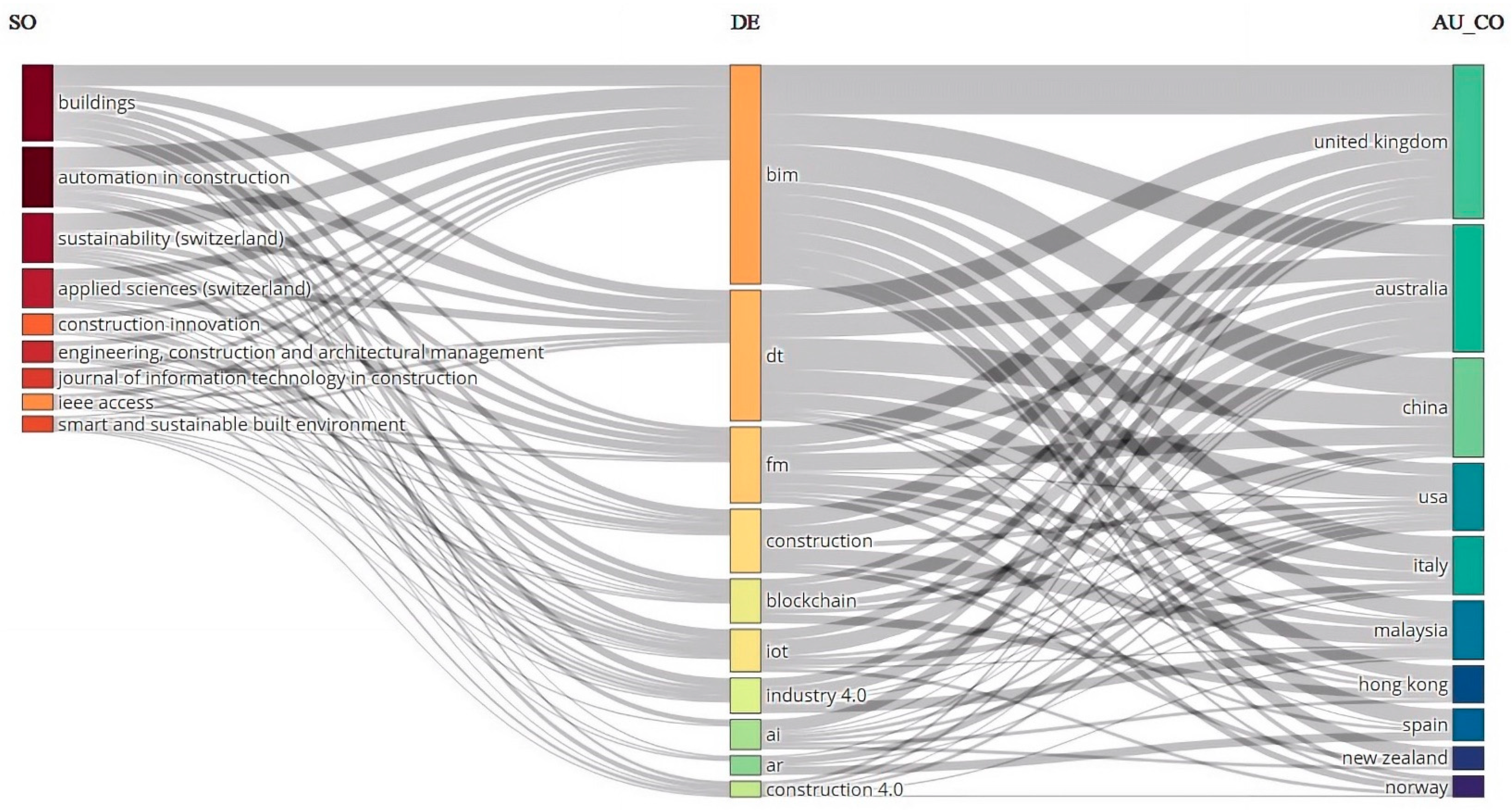

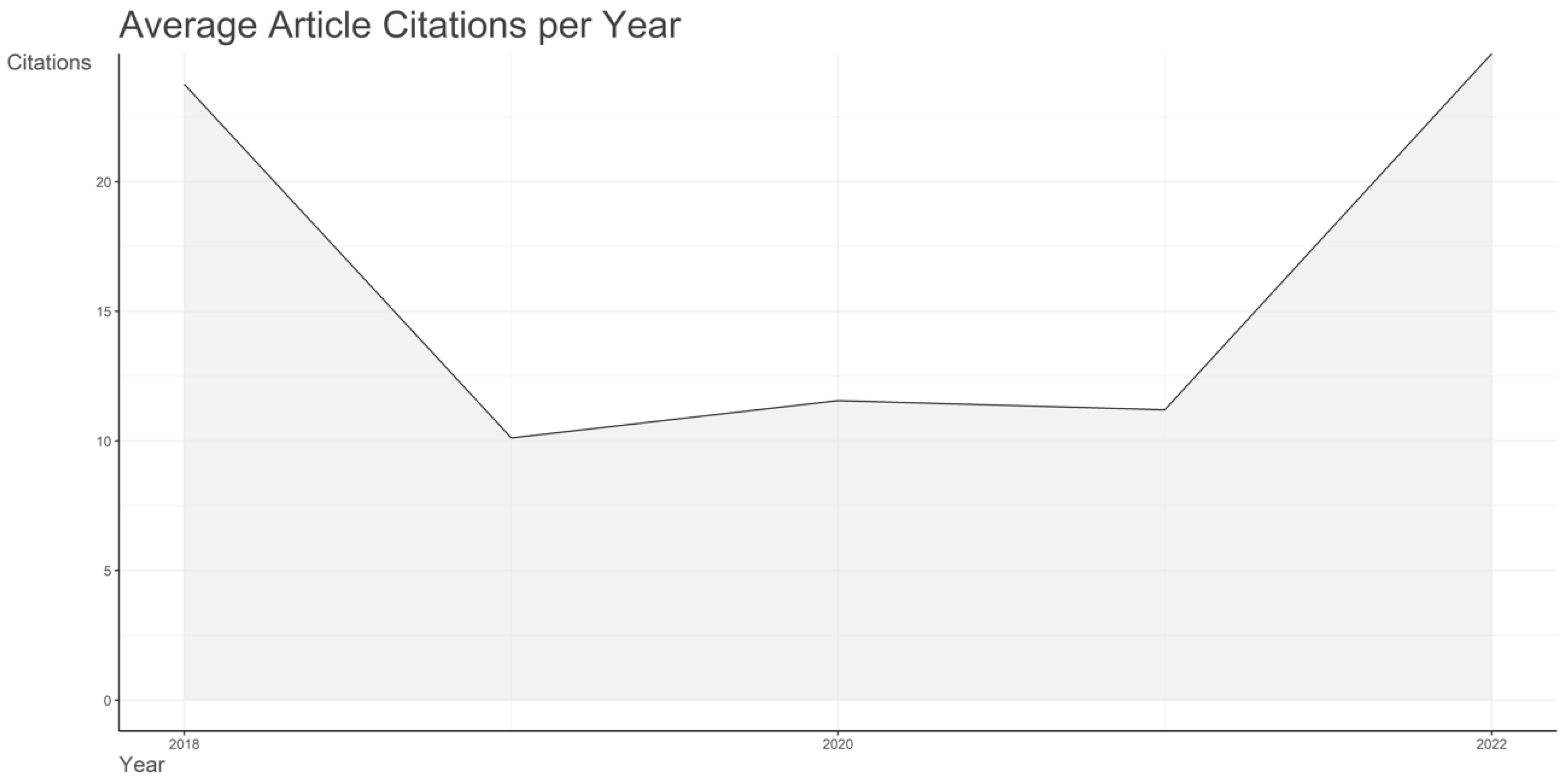
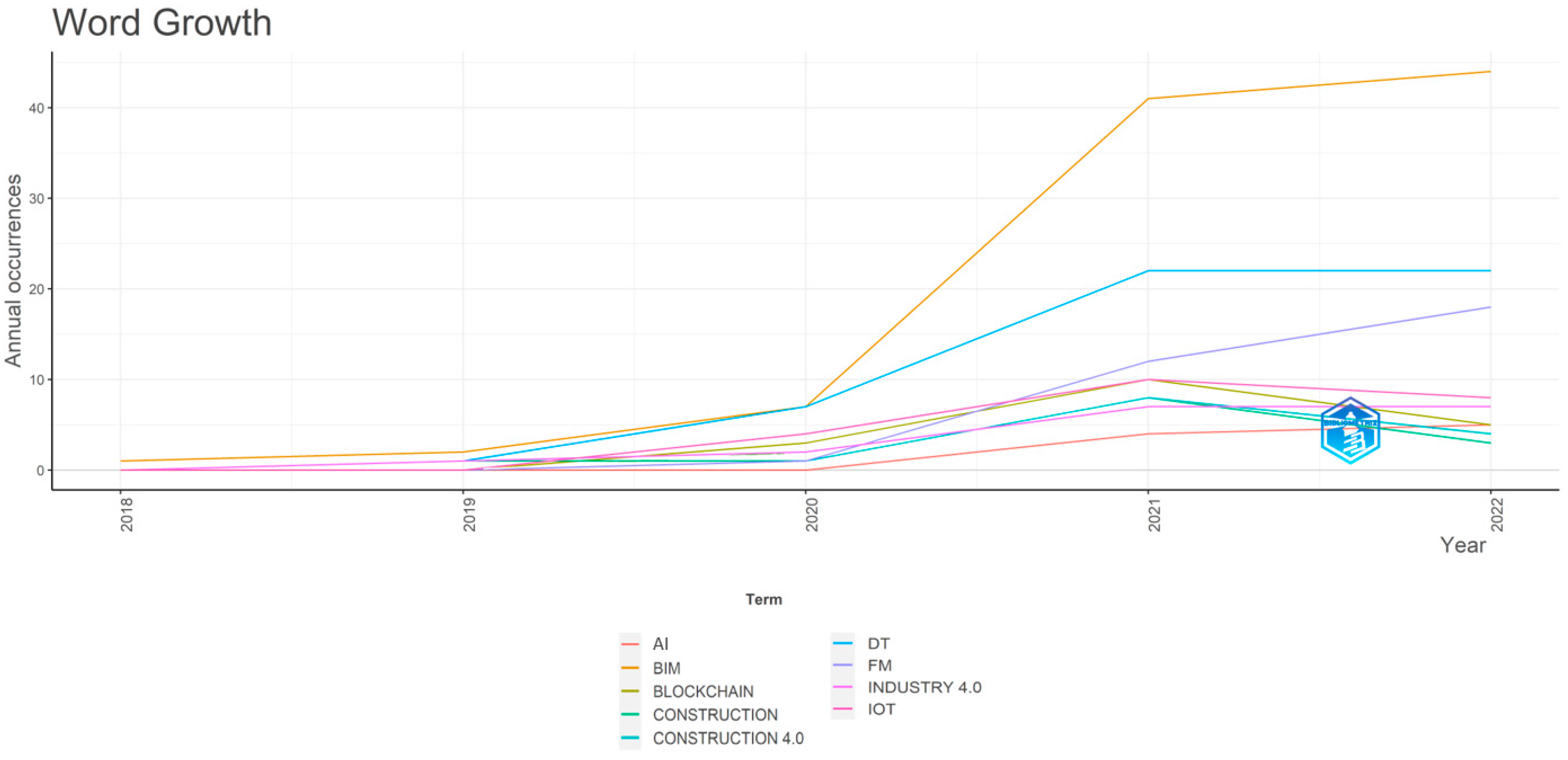
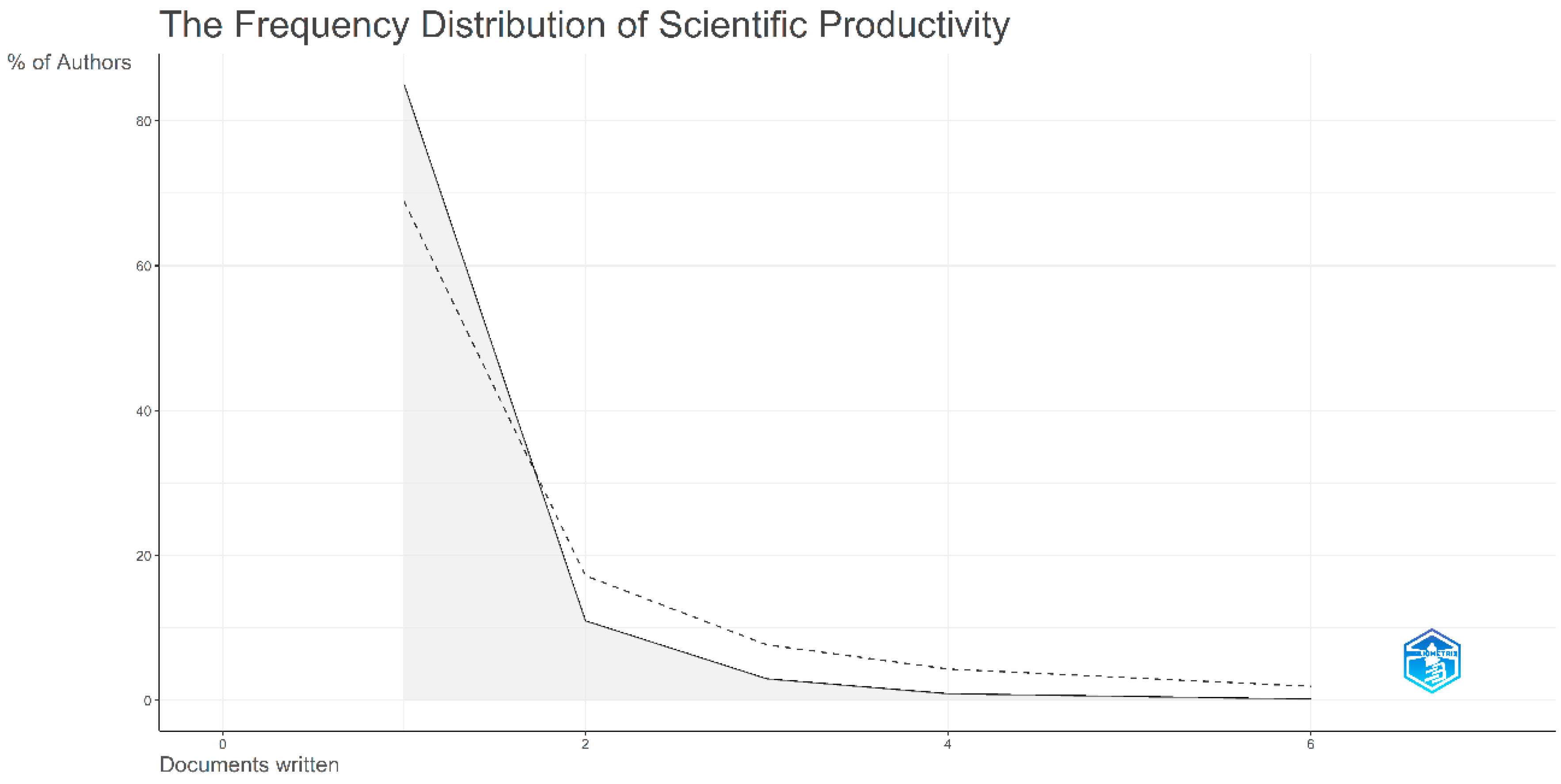
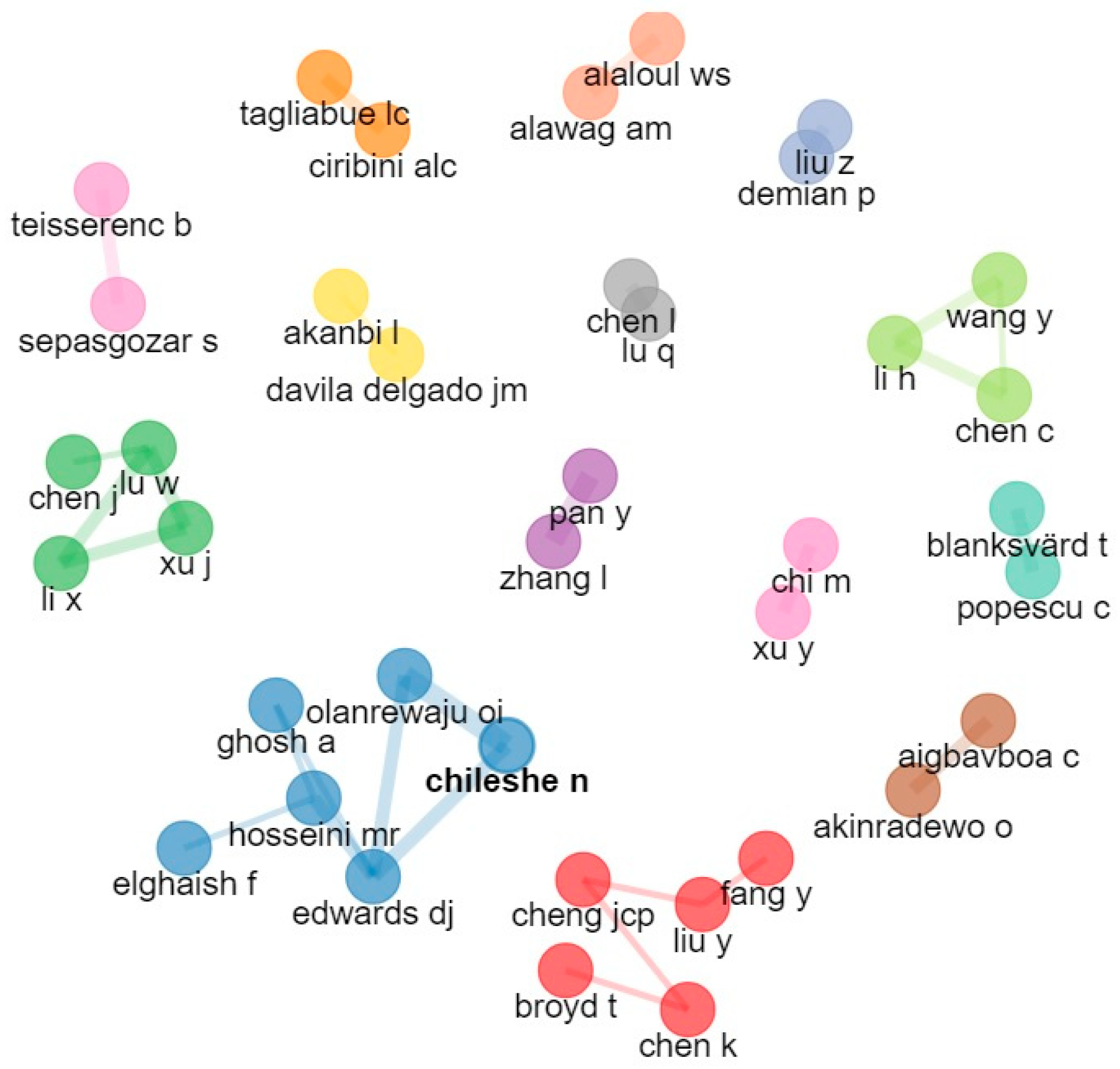
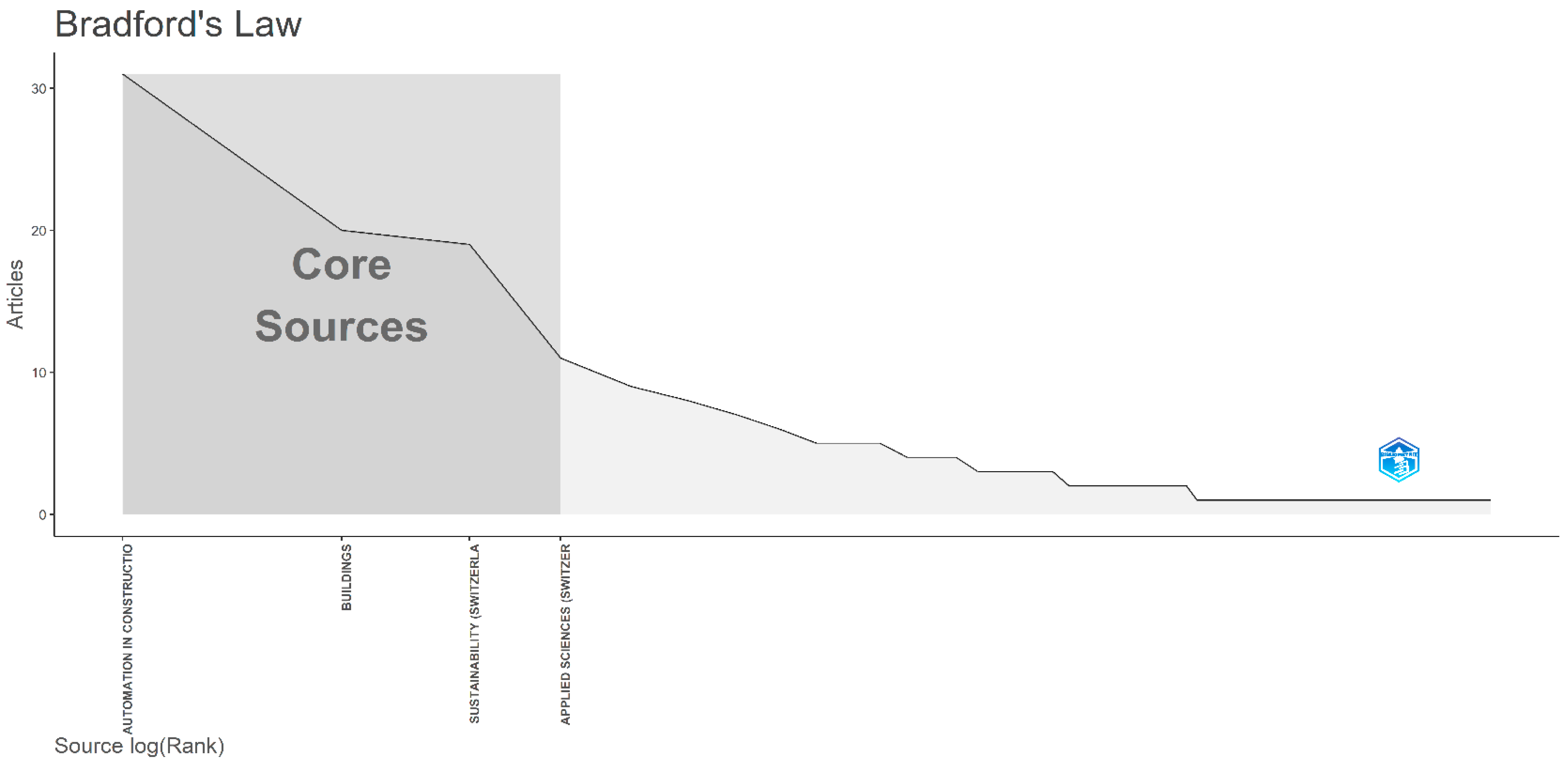
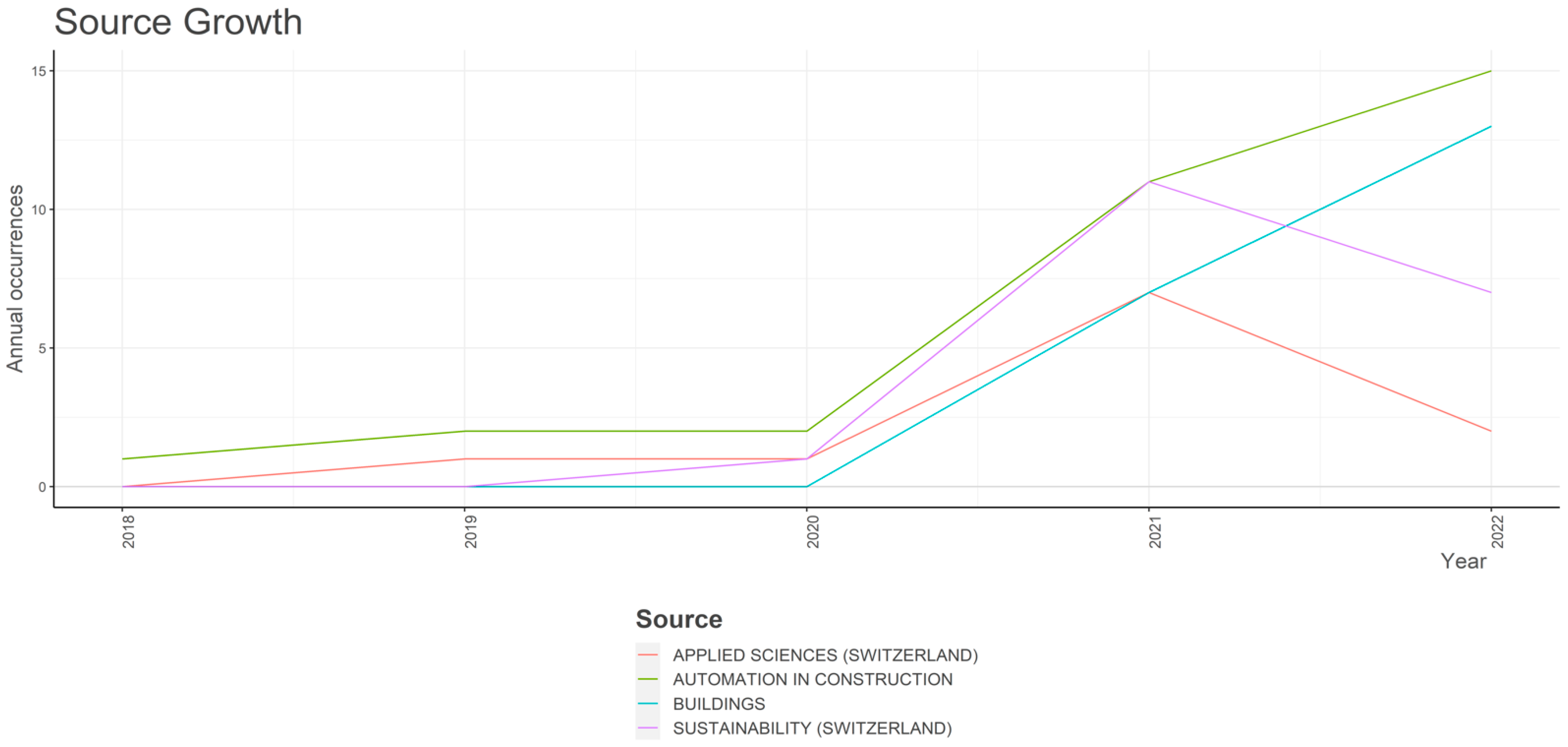
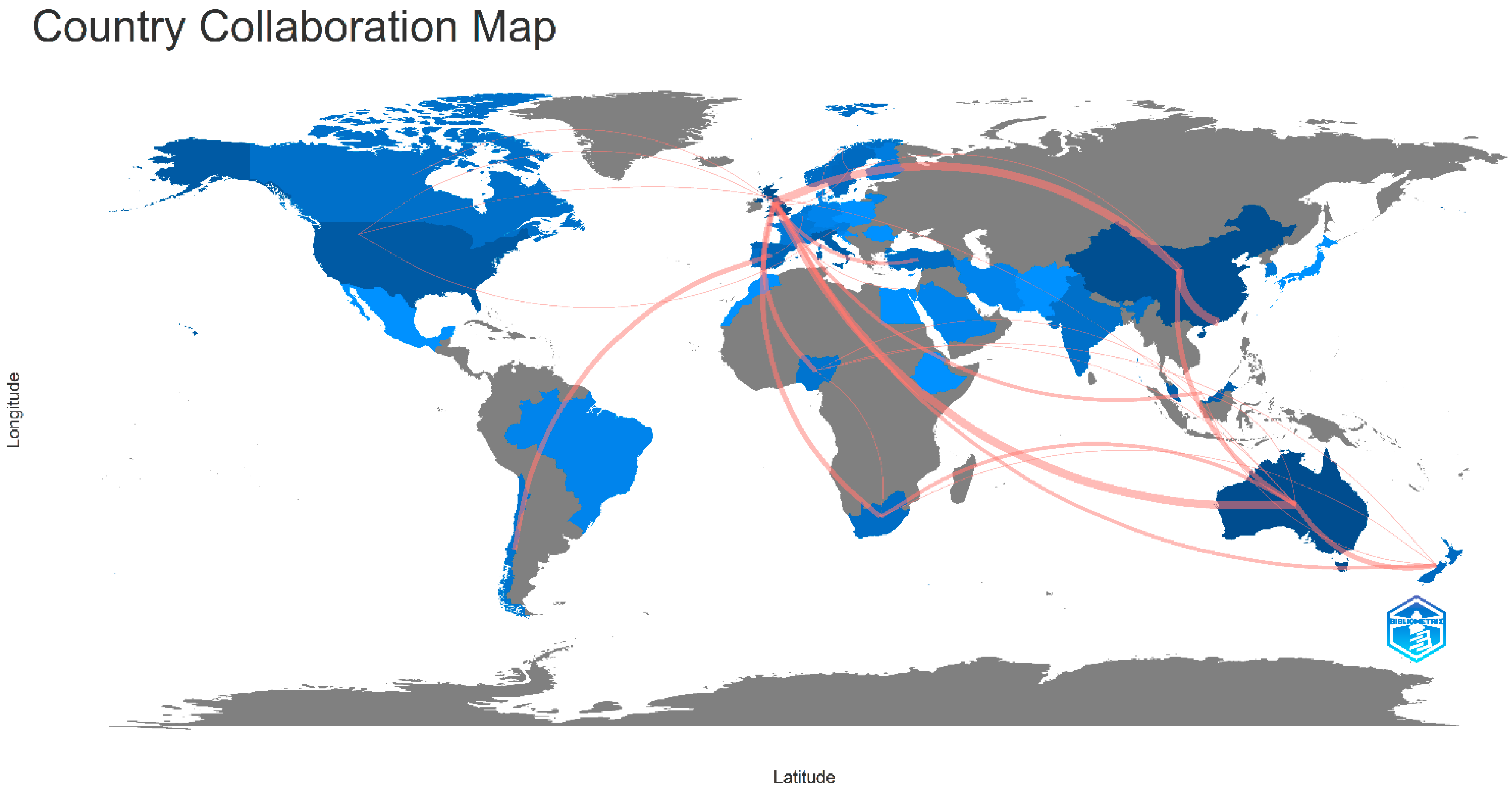
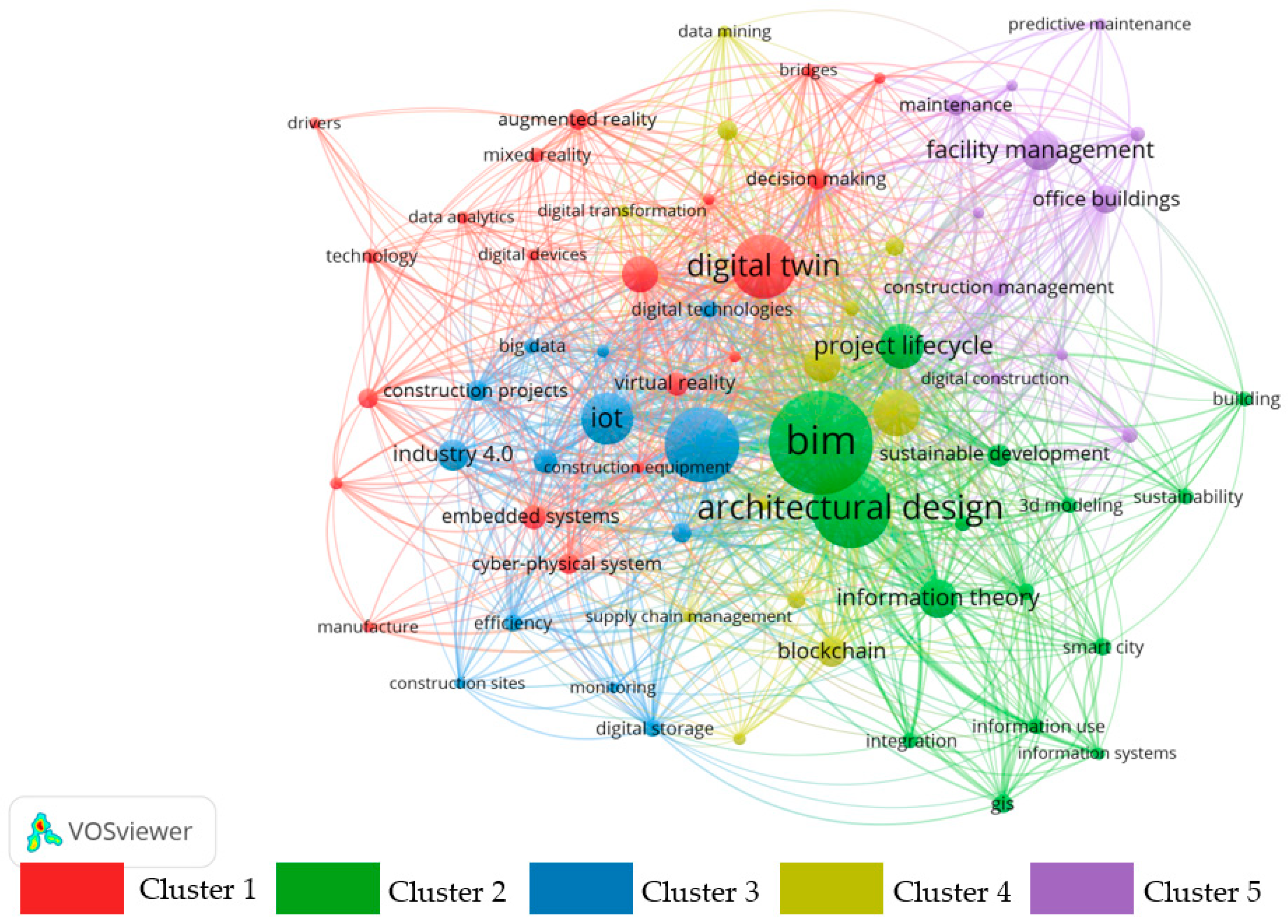
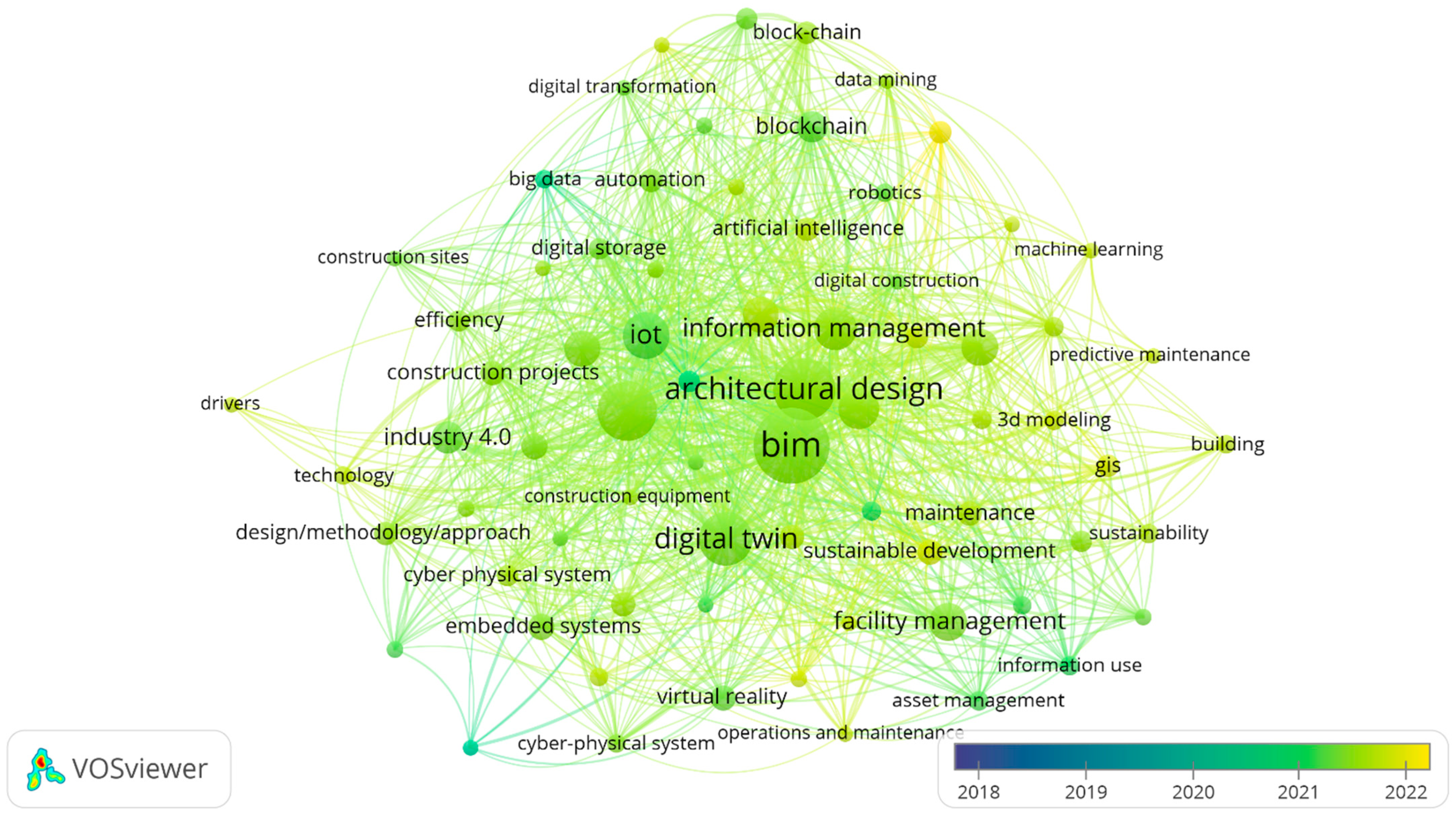
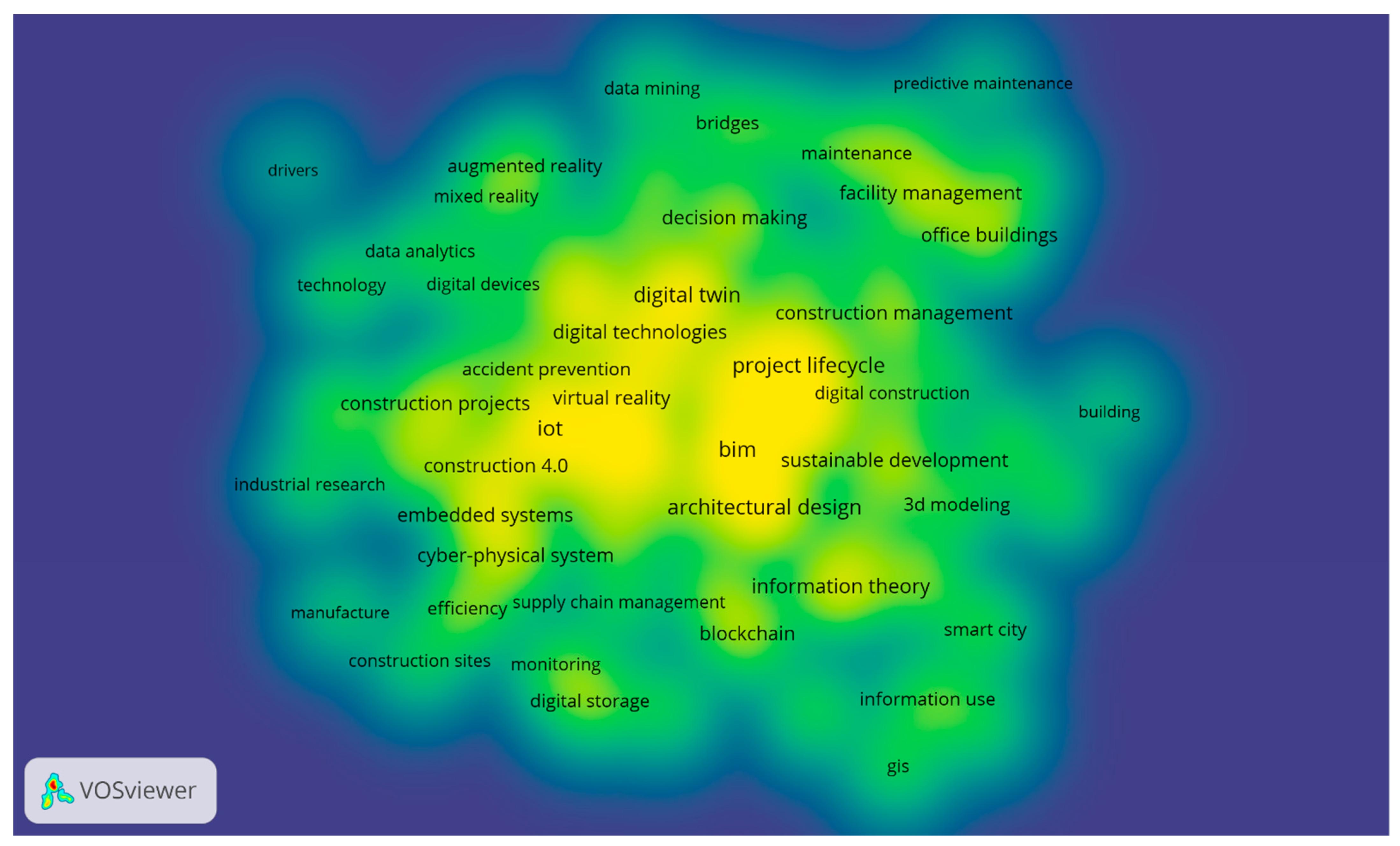
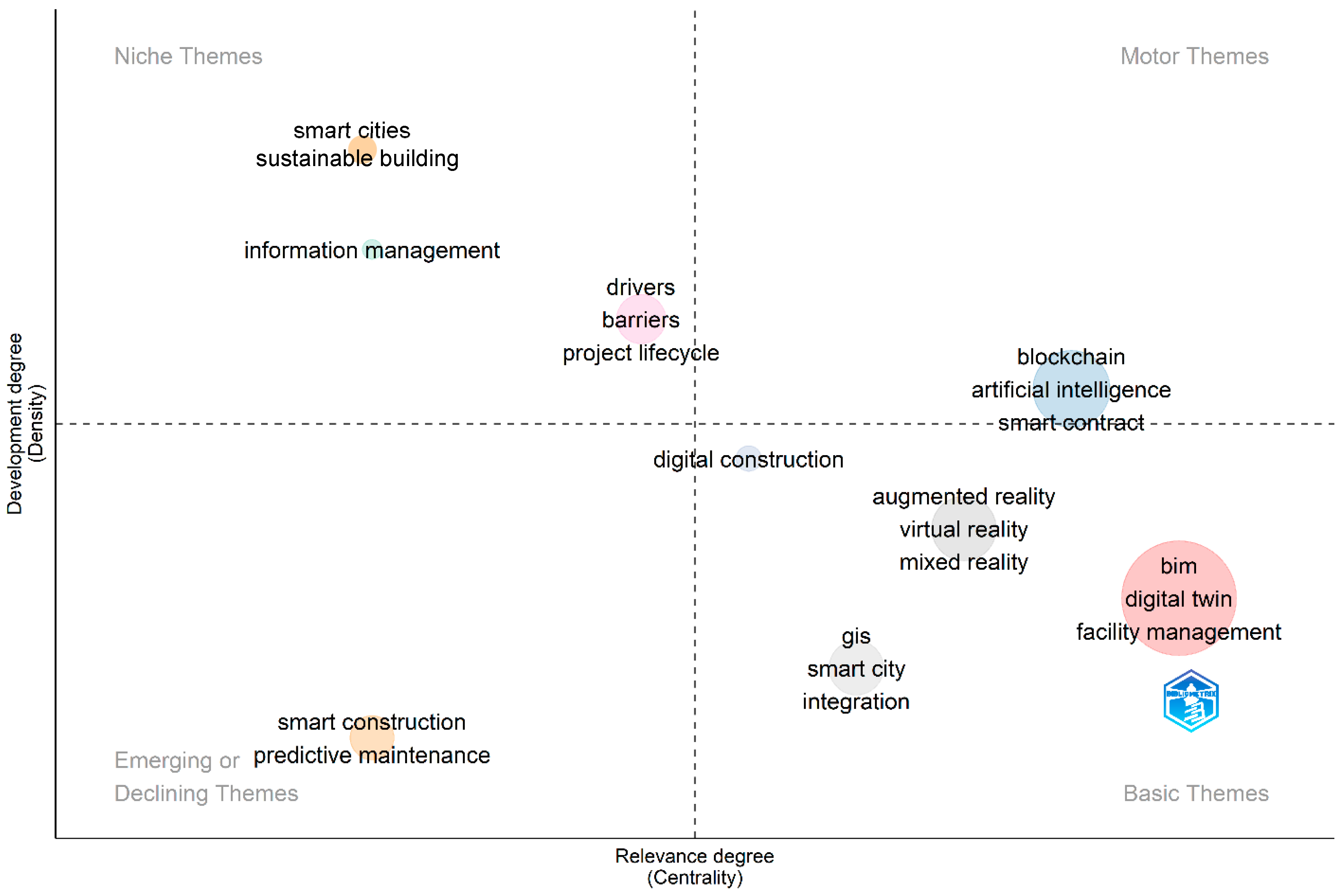
| Type of Analysis | Map Visualization | ||||||||||||
|---|---|---|---|---|---|---|---|---|---|---|---|---|---|
| Bibliometric Analysis Tools | Authors | Thematic | Reference | Evolution | Spectrogram | Geospatial | Network | Cluster | Geographical | Overlapping | Density | Overlay | Temporal |
| Bibexcel | ● | ● | ● | ● | ● | ||||||||
| Biblioshiny | ● | ● | ● | ● | ● | ● | ● | ● | ● | ● | ● | ||
| Bibliomaps | ● | ● | ● | ● | ● | ● | |||||||
| CiteSpace | ● | ● | ● | ● | ● | ● | ● | ||||||
| CitNetExplorer | ● | ● | |||||||||||
| SciMAT | ● | ● | ● | ● | ● | ● | ● | ● | |||||
| Sci2 Tool | ● | ● | ● | ● | ● | ● | ● | ● | |||||
| VOSviewer | ● | ● | ● | ● | ● | ● | ● | ● | |||||
| Topic | Synonyms | Normalized Term |
|---|---|---|
| Building information modelling | bim, building information modeling (bim), building information modelling (bim), building information modelling, building information modeling, BIM (BIM) | bim |
| Facility Management | fm, facilities management, construction management, asset management | fm |
| Internet of Things | iot, internet of things (IOT), internet of things, internet of thing | iot |
| Digital Twin | dt, digital twins, digital twin | dt |
| Virtual reality | virtual reality (vr), virtual reality | vr |
| augmented reality | augmented reality, augmented reality (ar) | ar |
| digitalization | Digitalisation, digitalization | digitalization |
| Smart contract | smart contracts, smart contract | smart contract |
| Smart building | Smart building, smart buildings, smart construction | Smart building |
| Construction industry | construction sector, construction, construction industry | construction industry |
| Dataset Information | |
| Total number of documents | 220 |
| Timespan | 2018:2022 |
| Sources | 76 |
| Average citations per document | 9.49 |
| Document type | |
| Article | 122 |
| Review | 67 |
| Conference paper | 25 |
| Book | 4 |
| Book chapter | 1 |
| Editorial | 1 |
| Authors | |
| Number of authors | 675 |
| Authors of single-authored docs | 15 |
| Authors’ collaboration | |
| Single-authored documents | 16 |
| Co-authors per document | 3.69 |
| Document contents | |
| Keywords Plus | 1216 |
| Author’s Keywords | 657 |
| Authors | Country | Documents |
|---|---|---|
| Edwards D.J. | UK | 6 |
| Chileshe N. | Australia | 4 |
| Elghaish F. | UK | 4 |
| Li H. | Hong Kong | 4 |
| Liu Y. | Hong Kong | 4 |
| Liu Z. | China | 4 |
| Xu Y. | China | 4 |
| Anumba C.J. | USA | 3 |
| Chen C. | China | 3 |
| Hosamo H.H. | Norway | 3 |
| Index | Pros | Cons |
|---|---|---|
| H-index | ||
| G-index |
| |
| M-index |
|
| Authors | H-Index | G-Index | M-Index | Total Citation | Number of Publications | Start of the Publication Years |
|---|---|---|---|---|---|---|
| Edwards D.J. | 5 | 6 | 1.667 | 127 | 6 | 2020 |
| Chileshe N. | 3 | 4 | 1.5 | 31 | 4 | 2021 |
| Munoz-La Rivera F. | 3 | 3 | 1.5 | 44 | 3 | 2021 |
| Olanrewaju O.I. | 3 | 3 | 1.5 | 30 | 3 | 2021 |
| Pan Y. | 3 | 3 | 1.5 | 248 | 3 | 2021 |
| Sepasgozar S. | 3 | 3 | 1.5 | 43 | 3 | 2021 |
| Xu Y. | 3 | 3 | 1.5 | 15 | 4 | 2021 |
| Zhang L. | 3 | 3 | 1.5 | 248 | 3 | 2021 |
| Akanbi L. | 2 | 2 | 1 | 53 | 2 | 2021 |
| Ali K.N. | 2 | 2 | 0.5 | 88 | 2 | 2019 |
| Paper | Total Citations | Total Citations per Year | Normalized Total Citations |
|---|---|---|---|
| Boje C., 2020, Automation in construction | 206 | 68.67 | 8.32 |
| Pan Y., 2021, Automation in construction -a-b | 144 | 72.00 | 11.26 |
| Wong J.K.W., 2018, Automation in construction | 100 | 20.00 | 1.00 |
| Pan Y., 2021, Automation in construction -a | 85 | 42.50 | 6.65 |
| Maskury R., 2019, Applied sciences (Switzerland) | 79 | 19.75 | 2.51 |
| Love Ped, 2019, Automation in construction | 58 | 14.50 | 1.84 |
| Hunag M.Q., 2021, Tunnelling and Underground Space technology | 53 | 26.50 | 4.15 |
| Forcael E., 2020, Sustainability (Switzerland) | 49 | 16.33 | 1.98 |
| Opoku D-GJ, 2021, Journal of Building Engineering | 47 | 23.50 | 3.68 |
| Ghosh A., 2021, Engineering, Construction and Architectural Management | 40 | 20.00 | 3.13 |
| Source | Number of Documents |
|---|---|
| Automation in Construction | 31 |
| Buildings | 20 |
| Sustainability Applied Sciences | 19 11 |
| Engineering, Construction and Architectural Management | 9 |
| Journal of Information Technology in Construction | 8 |
| Smart and Sustainable Built Environment | 7 |
| Construction Innovation | 6 |
| Advances in Civil engineering IEEE Access | 5 5 |
| Sources | H-Index | G-Index | M-Index | Total Citation | Number of Documents | Start of the Publication Years |
|---|---|---|---|---|---|---|
| Automation in construction | 11 | 28 | 2.2 | 812 | 31 | 2018 |
| Sustainability | 7 | 13 | 2.333 | 188 | 19 | 2020 |
| Applied Sciences | 6 | 11 | 1.5 | 162 | 11 | 2019 |
| Buildings | 6 | 9 | 3 | 95 | 20 | 2021 |
| Engineering, construction and architectural management | 4 | 8 | 2 | 70 | 9 | 2021 |
| Journal of building engineering | 4 | 5 | 2 | 96 | 5 | 2021 |
| Journal of information technology in construction | 4 | 8 | 1.333 | 85 | 8 | 2020 |
| Advanced engineering informatics | 3 | 3 | 1.5 | 21 | 3 | 2021 |
| Advances in civil engineering | 3 | 5 | 1 | 25 | 5 | 2020 |
| Archives of computational methods in engineering | 3 | 3 | 1.5 | 58 | 3 | 2021 |
| Country | Number of Documents |
|---|---|
| China | 64 |
| UK | 56 |
| Australia Italy | 54 32 |
| USA | 31 |
| Malaysia | 25 |
| Spain | 19 |
| New Zealand | 10 |
| Norway Portugal | 9 9 |
| Affiliations | Country | Number of Documents |
|---|---|---|
| University of Johannesburg | South Africa | 7 |
| Birmingham City University | UK | 6 |
| Shenzhen University | China | 6 |
| University of South Australia | Australia | 6 |
| Western Sidney University | Australia | 6 |
| Deakin University | Australia | 6 |
| Northumbria University | UK | 5 |
| The University of Hong Kong | Hong Kong | 5 |
| University of Florida | USA | 5 |
| Universitat Politecnica de Catalunya | Spain | 5 |
Disclaimer/Publisher’s Note: The statements, opinions and data contained in all publications are solely those of the individual author(s) and contributor(s) and not of MDPI and/or the editor(s). MDPI and/or the editor(s) disclaim responsibility for any injury to people or property resulting from any ideas, methods, instructions or products referred to in the content. |
© 2022 by the authors. Licensee MDPI, Basel, Switzerland. This article is an open access article distributed under the terms and conditions of the Creative Commons Attribution (CC BY) license (https://creativecommons.org/licenses/by/4.0/).
Share and Cite
Siccardi, S.; Villa, V. Trends in Adopting BIM, IoT and DT for Facility Management: A Scientometric Analysis and Keyword Co-Occurrence Network Review. Buildings 2023, 13, 15. https://doi.org/10.3390/buildings13010015
Siccardi S, Villa V. Trends in Adopting BIM, IoT and DT for Facility Management: A Scientometric Analysis and Keyword Co-Occurrence Network Review. Buildings. 2023; 13(1):15. https://doi.org/10.3390/buildings13010015
Chicago/Turabian StyleSiccardi, Stefania, and Valentina Villa. 2023. "Trends in Adopting BIM, IoT and DT for Facility Management: A Scientometric Analysis and Keyword Co-Occurrence Network Review" Buildings 13, no. 1: 15. https://doi.org/10.3390/buildings13010015
APA StyleSiccardi, S., & Villa, V. (2023). Trends in Adopting BIM, IoT and DT for Facility Management: A Scientometric Analysis and Keyword Co-Occurrence Network Review. Buildings, 13(1), 15. https://doi.org/10.3390/buildings13010015








